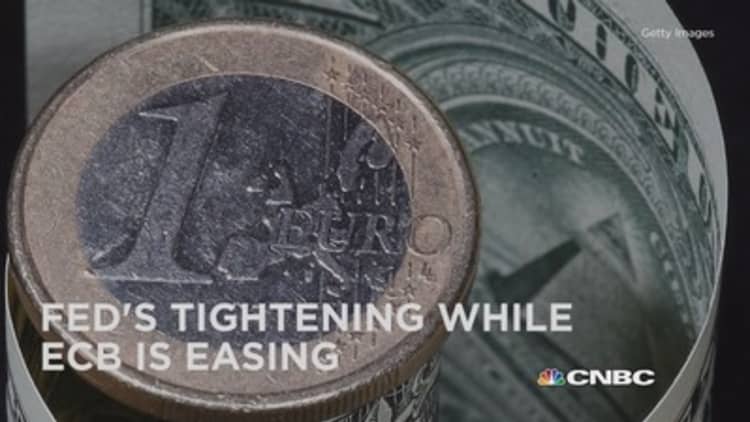
Dollar bulls are not ready to throw in the towel and are still betting diverging central bank policy sends the euro to parity with the U.S. currency later this year.
Weak technicals for the greenback are making some investors squirm, as the euro charges ahead and looks set to score more gains. That is the battleground for the dollar, which was higher against the pound, the yen and emerging market currencies Thursday.
"We still have our forecast in euro/dollar ending the year at parity, and we remain comfortable with that, mainly because we see the slowdown we had in the last couple of months as transitory," said Ian Gordon, senior foreign exchange strategist at Bank of America Merrill Lynch.
The dollar index has lost 3.7 percent in the month of April and 2.5 percent in just the last week. It finished Wednesday below its 100-day moving average at 94.82, further spooking investors. It was trading around that late Thursday.
"Some people think the dollar topped, but I don't believe it," said Marc Chandler, chief currency strategist at Brown Brothers Harriman. "We've seen part of the move but we haven't even had policy tightening yet. The divergence hasn't peaked. The Fed will be moving sooner or later, maybe later."
Since the dollar's direction hinges on Fed expectations, strategists say a turning point could come next week when April nonfarm payrolls are reported Friday. Employment and inflation are two Fed mandates that it considers when it looks to hike rates, and March's squishy nonfarm payrolls of just 126,000 helped reinforce the view of a central bank that could be easier for longer.
The dollar reversed some losses Thursday when weekly jobless claims data was the best in 15 years, signaling strength in the job market. The employment cost index rose 0.7 percent, showing the start of a pickup in wage inflation.
The dollar was crushed Wednesday as a weak first-quarter GDP report raised concerns that the slowdown that took growth to just 0.2 percent would be more than a passing first-quarter event. If that's true, it would push out expectations for the Fed's first rate hike, now expected around October, Gordon said.
"We do think the data is going to rebound, and that's going to support the dollar and also validate the Fed's view that the slowdown is due to transitory factors and that will bring in expectations for the timing of the first rate hike," said Gordon. He projects the first rate increase to be in September.
"Compared to winters over the past 40 to 50 years, it was the 10th most intense winter we've had," he said, commenting on a BofA extreme weather index.
Read MoreTake that strong dollar! Euro soars
The euro has been gaining as sovereign rates there climb rapidly, and the data have shown progress on the inflation front and in bank lending. The common currency reached a high near $1.125, an important technical level that Chandler said opens the door to a move to $1.15.
"It seems to me you have this huge position adjustment—long Germany (bunds), short euro. These positions are being unwound," said Chandler.
Read MoreGross: German bunds are short of a lifetime
Major investors—like Bill Gross at Janus Capital and DoubleLine's Jeffrey Gundlach—have turned against European sovereigns, as the yield on the 10-year bund crept lower and lower. Traders have been betting its yield would turn negative, but it's been under strong selling pressure in the last two days and was yielding about 0.36 percent, compared to the 2.09 percent yield on the U.S. Treasury.
"Some of the same ones that are selling Europe were selling the JGBs (Japanese government bonds), and that's why JGBs are known as the widow maker," said Chandler. "If we don't fight the Fed, why should we fight the ECB. ... They have a printing press."
Read MoreData shows improvement on the jobs front
"if we take out, $1.1265, I think the next target is close to $1.15. $1.18 is possible. I think it's a bit of a stretch," he said. Chandler said the $1.16 to $1.165 area is a zone he is watching for a double bottom in the dollar. "In order for me to say the euro's bear market is set to resume we have to get back below $1.1050," he said.
"Most of Europe and Asia is closed for May Day on Friday. It's a thin market from here out. If you're a bull on the dollar, it would be nice to see it close above the 100-day on a weekly basis," Chandler said.
Alan Ruskin, head of G-10 currency strategy at Deutsche Bank, said the dollar technicals are messy and investors may be waiting for the currency to gain support at a lower level.
"The poor USD seasonal in April that have given way to a stronger May in the last six years will amount to little if the May 8 payroll is not at least decent," he wrote in a note. "That said, from a medium-term perspective until we retreat from a view that the Fed will tighten this year, the M/T USD view is unchanged."
He said all data is secondary to the May 8 April payrolls and the "pain trade now probably surrounds stronger USD data."
Deutsche Bank economists expect to see 225,000 nonfarm payrolls for April.


